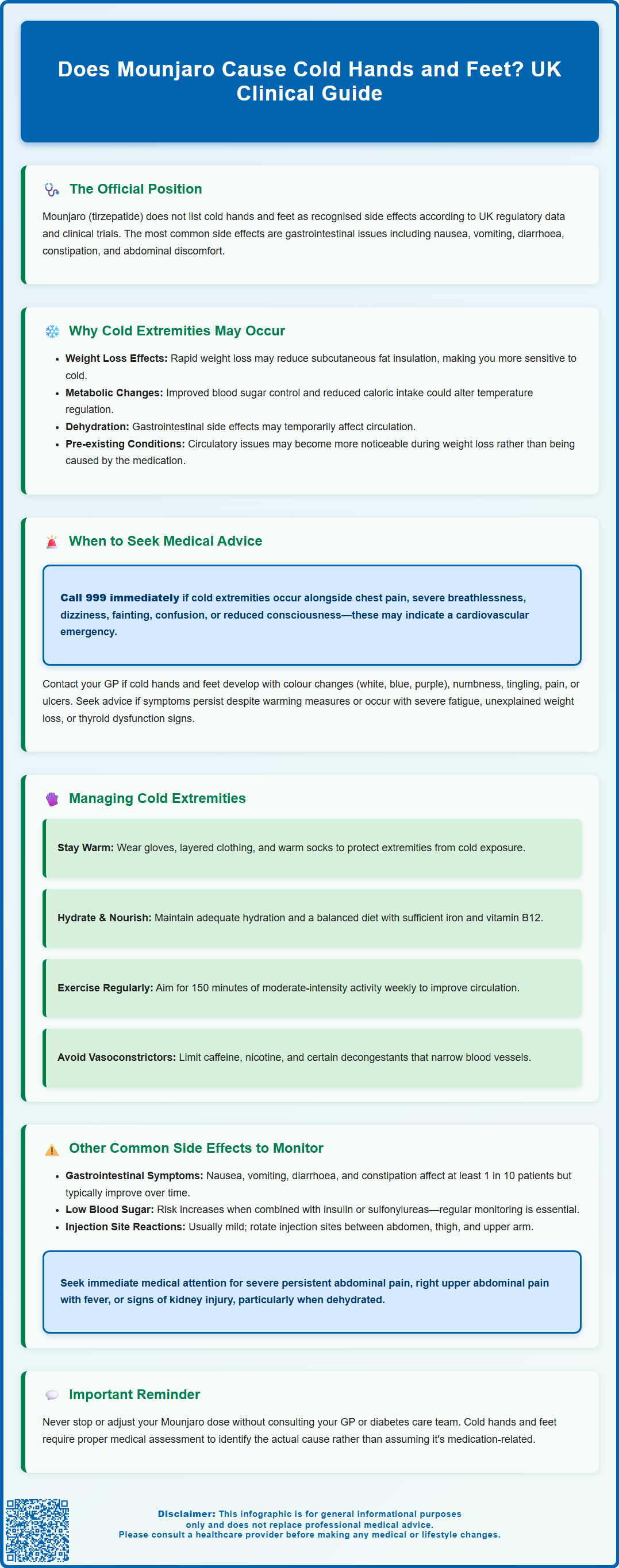Mounjaro®
Dual-agonist support that helps curb appetite, hunger, and cravings to drive substantial, sustained weight loss.
- ~22.5% average body weight loss
- Significant weight reduction
- Improves blood sugar levels
- Clinically proven weight loss

Mounjaro (tirzepatide) is a dual GLP-1 and GIP receptor agonist licensed in the UK for treating type 2 diabetes mellitus. Whilst cold hands and feet are not listed as recognised adverse effects in the MHRA Summary of Product Characteristics, some patients report experiencing cold extremities during treatment. This symptom may relate to weight loss, metabolic changes, or underlying conditions rather than a direct medication effect. Understanding when cold extremities warrant medical attention and how to manage them safely is important for patients taking Mounjaro.
Summary: Cold hands and feet are not recognised adverse effects of Mounjaro (tirzepatide) according to UK regulatory data, though some patients report this symptom during treatment.
Mounjaro (tirzepatide) is a glucagon-like peptide-1 (GLP-1) and glucose-dependent insulinotropic polypeptide (GIP) receptor agonist licensed in the UK for the treatment of type 2 diabetes mellitus. According to the current MHRA Summary of Product Characteristics (SmPC), cold hands and feet are not listed as recognised adverse effects of tirzepatide.
It is important to note that there is no established link between tirzepatide and cold hands or feet based on clinical trial data and post-marketing surveillance. The most frequently reported side effects of Mounjaro include gastrointestinal symptoms such as nausea, vomiting, diarrhoea, constipation, and abdominal discomfort. However, some patients have anecdotally reported experiencing cold extremities during treatment, though this has not been confirmed as a direct medication effect.
Patients experiencing new or persistent cold hands and feet whilst taking Mounjaro should not automatically attribute this symptom to the medication alone. Cold extremities can result from numerous underlying causes, including poor circulation, thyroid dysfunction, anaemia, Raynaud's phenomenon, or other cardiovascular conditions. A thorough clinical assessment is essential to determine whether the symptom is coincidental, related to weight loss and metabolic changes, or indicative of an unrelated medical condition requiring investigation and management.
If you are taking Mounjaro and experiencing cold extremities or any other concerning symptoms, do not stop or change your dose without consulting your GP or diabetes care team.

Although cold hands and feet are not documented adverse effects of Mounjaro in the SmPC, several hypothetical mechanisms might explain why some individuals report these symptoms during treatment. Rapid weight loss, which can occur with tirzepatide treatment, may lead to changes in body composition, including reduced subcutaneous fat. This fat layer provides insulation and helps maintain peripheral body temperature. As patients lose weight, they may potentially become more sensitive to cold temperatures.
Metabolic changes associated with improved glycaemic control and weight reduction might also play a role. Tirzepatide works by enhancing insulin secretion in a glucose-dependent manner, suppressing glucagon secretion, and slowing gastric emptying. These effects, combined with reduced caloric intake due to appetite suppression, can alter metabolism, though there is no direct evidence linking these changes to cold extremities specifically with tirzepatide.
Dehydration is another consideration, particularly if patients experience gastrointestinal side effects such as vomiting or diarrhoea. The MHRA SmPC for Mounjaro notes that gastrointestinal adverse reactions can cause dehydration, which may temporarily affect circulation. Maintaining adequate hydration is important, especially during episodes of gastrointestinal upset.
It is worth noting that individuals with pre-existing circulatory conditions, such as peripheral arterial disease or Raynaud's phenomenon, may notice their symptoms become more apparent during treatment with any medication that causes weight loss or metabolic changes. This would not represent a new drug-induced effect but rather an unmasking of underlying pathology. These hypotheses remain speculative, as there is currently insufficient evidence to establish a direct causal relationship between tirzepatide and cold extremities.
Whilst cold hands and feet alone are rarely a cause for immediate concern, certain accompanying symptoms warrant prompt medical evaluation. Patients should contact their GP or diabetes care team if cold extremities are accompanied by colour changes (such as white, blue, or purple discolouration), numbness, tingling, pain, or ulceration of the fingers or toes. These features may indicate more serious circulatory problems, including Raynaud's phenomenon, peripheral arterial disease, or vasculitis, which require specific investigation and management.
Call 999 immediately if cold extremities occur alongside chest pain, severe shortness of breath, dizziness, fainting, or signs of poor perfusion such as confusion or reduced consciousness. These symptoms could indicate cardiovascular compromise requiring emergency assessment. For urgent but non-emergency concerns, contact NHS 111 for advice.
Similarly, if cold hands and feet develop suddenly after starting Mounjaro and are associated with other concerning symptoms such as severe fatigue, unexplained weight loss beyond expected therapeutic effect, or signs of thyroid dysfunction (such as hair loss, dry skin, or persistent fatigue), further investigation is warranted.
Patients should also inform their healthcare professional if cold extremities persist despite simple warming measures or if the symptom significantly impacts quality of life. A thorough clinical assessment may include:
Cardiovascular examination to assess peripheral pulses and circulation
Blood tests including full blood count (to exclude anaemia), thyroid function tests, and assessment of glycaemic control
Review of concurrent medications that might affect circulation
Assessment of hydration status and nutritional adequacy
NICE guidance emphasises the importance of regular monitoring during GLP-1 receptor agonist therapy, and any new or persistent symptoms should be discussed during routine follow-up appointments or sooner if concerning.
For patients experiencing cold hands and feet during Mounjaro treatment without concerning features, several practical strategies may provide relief. Maintaining adequate warmth is fundamental—wearing appropriate clothing including gloves, warm socks, and layered garments can help preserve body heat. Avoiding sudden temperature changes and protecting extremities from cold exposure, particularly during winter months, is advisable. Some patients find that keeping their core body temperature warm through appropriate clothing helps maintain peripheral circulation.
Ensuring adequate hydration and nutrition is essential, particularly given that Mounjaro can cause gastrointestinal side effects that may compromise fluid and nutrient intake. Patients should aim to drink sufficient fluids throughout the day and maintain a balanced diet that supports their metabolic needs during weight loss. If appetite suppression makes adequate nutrition challenging, working with a dietitian to develop an appropriate eating plan may be beneficial. A balanced diet with adequate iron and vitamin B12 can help prevent deficiency-related causes of cold extremities, but do not start supplements unless advised by a healthcare professional after appropriate testing.
Regular physical activity can improve peripheral circulation. The UK Chief Medical Officers recommend that adults engage in at least 150 minutes of moderate-intensity aerobic activity per week, which can support cardiovascular health and circulation. Activities such as brisk walking, swimming, or cycling can be particularly beneficial. Patients should discuss appropriate exercise plans with their healthcare professional, especially if they have pre-existing cardiovascular conditions.
Avoiding vasoconstrictive substances such as caffeine, nicotine, and certain decongestant medications may help, as these can narrow blood vessels and reduce peripheral blood flow. Smoking cessation is particularly important for overall cardiovascular health and circulation. The NHS offers free support to help people stop smoking through local Stop Smoking Services.
If cold extremities persist despite these measures, patients should discuss the symptom with their prescriber. Do not adjust your Mounjaro dose or stop treatment without consulting your healthcare professional.
Understanding the recognised adverse effect profile of Mounjaro helps patients distinguish between expected side effects and unusual symptoms requiring medical attention. According to the MHRA SmPC, gastrointestinal symptoms are the most frequently reported adverse effects. These include nausea (very common, affecting ≥1/10 patients), vomiting, diarrhoea, constipation, abdominal pain, and dyspepsia. These symptoms are typically mild to moderate in severity and often improve over time as the body adapts to treatment. Small, frequent meals and avoiding high-fat or spicy foods may help manage these effects.
Hypoglycaemia (low blood glucose) risk is mainly present when Mounjaro is used in combination with insulin or sulfonylureas. The doses of these medications may need to be reduced when starting tirzepatide. Patients should be educated about recognising symptoms of hypoglycaemia, including tremor, sweating, confusion, palpitations, and hunger. Regular blood glucose monitoring as advised by the healthcare team is essential, particularly during the initial months of treatment.
Injection site reactions, such as redness, itching, or discomfort at the injection site, occur in some patients but are usually mild and transient. Rotating injection sites (abdomen, thigh, or upper arm) can help minimise these reactions. More serious but less common adverse effects include:
Pancreatitis: Patients should seek immediate medical attention if they experience severe, persistent abdominal pain that may radiate to the back, often accompanied by nausea and vomiting. Tirzepatide should be discontinued if pancreatitis is suspected.
Gallbladder problems: Rapid weight loss increases the risk of gallstones; symptoms include right upper abdominal pain, fever, jaundice, particularly after eating fatty foods.
Diabetic retinopathy complications: Patients with pre-existing diabetic eye disease should have regular ophthalmology follow-up through the NHS Diabetic Eye Screening Programme.
Acute kidney injury: Maintaining adequate hydration is crucial, especially if experiencing gastrointestinal side effects.
The MHRA continues to monitor the safety profile of tirzepatide through pharmacovigilance programmes. Patients experiencing any unexpected or concerning symptoms should report these to their healthcare professional and can also report suspected side effects directly via the Yellow Card Scheme (yellowcard.mhra.gov.uk). Regular follow-up appointments allow for ongoing assessment of treatment efficacy, tolerability, and the need for any dose adjustments or additional investigations.
No, cold hands and feet are not listed as recognised adverse effects in the MHRA Summary of Product Characteristics for Mounjaro (tirzepatide). The most common side effects are gastrointestinal symptoms such as nausea, vomiting, and diarrhoea.
Contact your GP if cold hands and feet are accompanied by colour changes (white, blue, or purple), numbness, tingling, pain, or ulceration. Seek emergency care immediately if cold extremities occur with chest pain, severe breathlessness, or signs of poor circulation.
Possible explanations include weight loss reducing insulating subcutaneous fat, metabolic changes, dehydration from gastrointestinal side effects, or unrelated conditions such as poor circulation, thyroid dysfunction, or Raynaud's phenomenon requiring separate investigation.
The health-related content published on this site is based on credible scientific sources and is periodically reviewed to ensure accuracy and relevance. Although we aim to reflect the most current medical knowledge, the material is meant for general education and awareness only.
The information on this site is not a substitute for professional medical advice. For any health concerns, please speak with a qualified medical professional. By using this information, you acknowledge responsibility for any decisions made and understand we are not liable for any consequences that may result.
Lorem ipsum dolor sit amet, consectetur adipiscing elit, sed do eiusmod tempor incididunt ut labore et dolore magna aliqua. Ut enim ad minim veniam, quis nostrud exercitation ullamco laboris nisi ut aliquip ex ea commodo consequat. Duis aute irure dolor in reprehenderit in voluptate velit esse cillum dolore eu fugiat nulla pariatur.
Block quote
Ordered list
Unordered list
Bold text
Emphasis
Superscript
Subscript